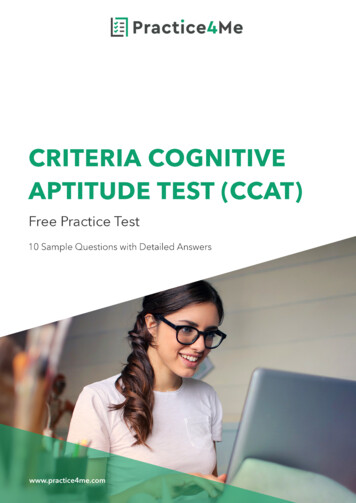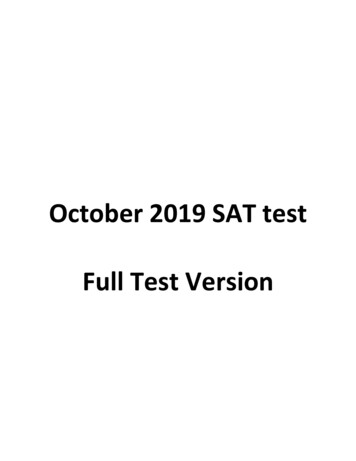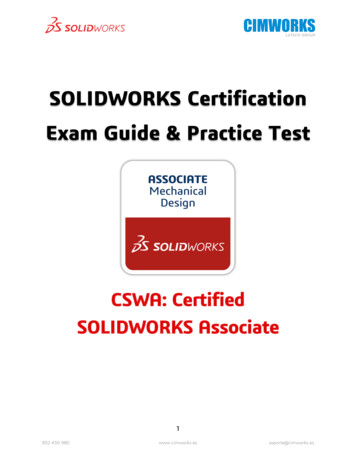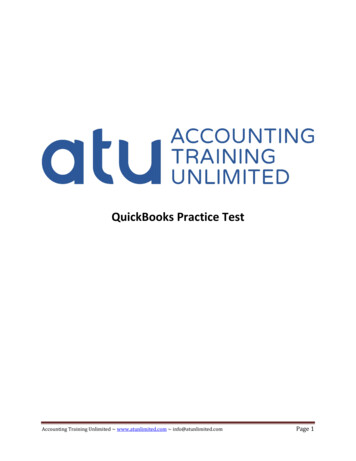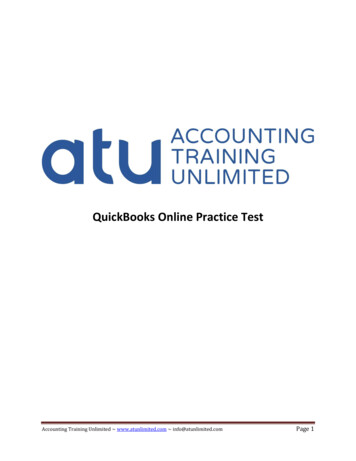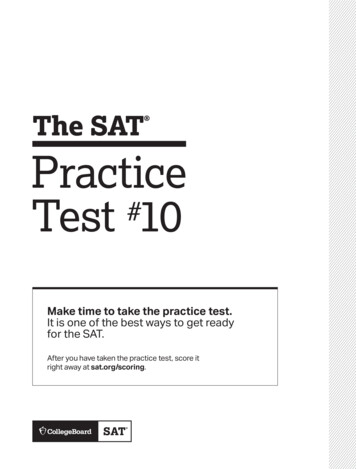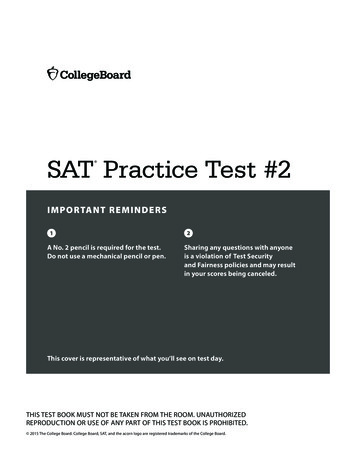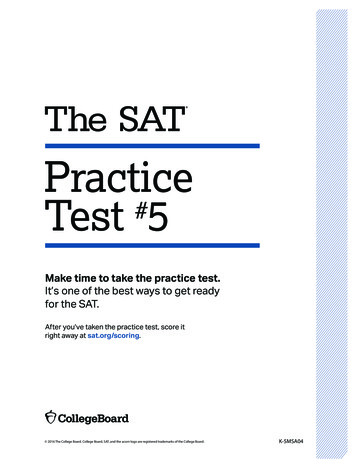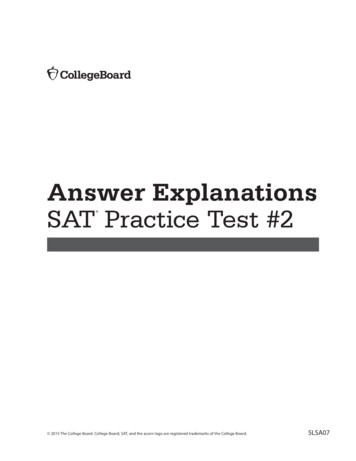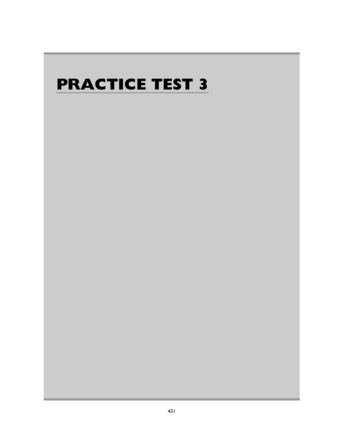
Transcription
PRACTICE TEST 3431
CHAPTER 14 / PRACTICE PSAT 3433ANSWER SHEETLast Name:First Name:Date:Testing Location:Administering the Test Remove this answer sheet from the book and use it to record your answers to this test.This test will require 2 hours and 10 minutes to complete. Take this test in one sitting.Use a stopwatch to time yourself on each section. The time limit for each section is written clearly at thebeginning of each section. The first four sections are 25 minutes long, and the last section is 30 minutes long.Each response must completely fill the oval. Erase all stray marks completely, or they may be interpreted as responses.You must stop ALL work on a section when time is called.If you finish a section before the time has elapsed, check your work on that section. You may NOT move onto the next section until time is called.Do not waste time on questions that seem too difficult for you.Use the test book for scratchwork, but you will only receive credit for answers that are marked on theanswer sheets.Scoring the Test Your scaled score, which will be determined from a conversion table, is based on your raw score foreach section.You will receive one point toward your raw score for every correct answer.You will receive no points toward your raw score for an omitted question.For each wrong answer on a multiple-choice question, your raw score will be reduced by 1/4 point. Foreach wrong answer on a numerical “grid-in” question (Section 4, questions 29 –38), your raw score willreceive no deduction.
434MC GRAW-HILL’S PSAT/NMSQT
CHAPTER 14 / PRACTICE PSAT 3435Section 1ÆzTime—25 minutes124 Questions (1 –24)Each sentence below has one or two blanks, each blank indicating that something has been omitted.Beneath the sentence are five words or sets of words labeled A through E. Choose the word or set ofwords that, when inserted in the sentence, best fits the meaning of the sentence as a whole.Example:Medieval kingdoms did not become constitutional republics overning; on the contrary, the changewas ---- ufficientgradualCorrect response: (E)B1The varicella virus, also know as the chickenpox virus, remains -- ---- in the nervoussystem, unbeknown to the host, and canreappear later in life as a condition knownas solitaryactiveaggressiveThe -- --- - businessman --- --- his unsuspecting partner of 15 years, embezzling largesums of money and secretly wiring it tohis bank account in the Cayman Islands.(A)(B)(C)(D)(E)Bdeceitful . . swindledduplicitous . . supportedadmirable . . rebukedambidextrous . . accommodatedethical . . dupedWhile her camp friends thought it wasnatural for her to feel so -- --- - after shebroke up with her boyfriend of three years,her incessant crying and -- --- - demeanorwere starting to get on their nerves.(A)(B)(C)(D)(E)B5mystified . . sanguineelated . . meticulousjubilant . . disheartenedirate . . joculardespondent . . melancholy“Rite of Spring” by twentieth-centuryRussian-American composer Igor Stravinskyis --- --- masterpiece to the enthusiasts of hiswork; but many cannot believe that the ---- -produced in this piece is anything more thandissonance set to irregular rhythms.(A)(B)(C)(D)(E)a sublime . . harmonya mortifying . . dissonancean abstract . . benevolencean aesthetic . . cacophonya trivial . . punctiliousnessAndré showed a great -- --- - for computers asa child; he wrote his first program at the ageof seven when most kids barely even knewwhat a computer ismantagonismGO ON TO THE NEXT PAGE Å Å Å
436MC GRAW-HILL’S PSAT/NMSQTEach passage below is followed by one or twoquestions based on its content. Answer eachquestion based on what is stated or impliedin the passage introductory material preceding it.Æz1This excerpt from a geological textbook discussesthe broad effects of volcanoes.Line Volcanoes are crucibles of change and are heldin fascination mainly for their awesome powersof destruction. In the span of human life, theycan change a landscape from jungle to desert,5 degrade the global climate, induce great floods,and even bury entire cities. Yet, volcanoes areultimately benevolent. The oceans in which lifebegan, and the lakes, rivers, and groundwatersthat renew and sustain life, are all condensed10 volcanic steam that was produced duringcountless eruptions over billions of years. Thevery air we breathe is a store of volcanic vapors.Wondrously fertile volcanic soils yieldsustenance for millions in tropical and15 temperate regions. Volcanic geothermalsystems that breach the surface as soothing hotsprings are also clean, safe, and renewablesources of electrical energy. The tallestvolcanoes wring moisture from passing clouds,20 creating glaciers as well as tumbling rivers thatendow us with hydroelectric power.B6The passage indicates that the water on theearth’s surface(A) is one of the main causes of volcanicactivity(B) originated beneath the earth’s surface(C) diminishes in abundance as more volcanoes become active(D) can temper the damaging effects ofvolcanoes(E) is more toxic in areas around activevolcanoesB7The following is from a textbook on logic writtenin 1986.Line What is reasoning? It is an inference, or chainof inferences. An inference is a mental state orprocess in which one or more beliefs support orlead to another belief. Thus I may observe that5 Bob has a temperature, and infer that he is sick.From the fact that Bob is sick, I may inferfurther that he should rest. I have described twoinferences which constitute a two-stepreasoning process. Inferences can be expressed10 in language in another way, as arguments. Anargument is a sequence of statements some ofwhich are offered as providing a sufficientreason to believe the others. The supportingstatements are called premises; the statements15 they support are called conclusions. Anargument, therefore, is a linguistic unit inwhich premises are stated from whichconclusions are drawn.B8The main purpose of this passage is toprovide(A)(B)(C)(D)(E)B9a brief history of a phenomenona humorous vignettea justification of a positiona set of definitionsa refutation of a common misconceptionIf the statements in lines 4 –7 constitute asingle argument, then which of the followingrepresent all of the “premises” among thesestatements?(A)(B)(C)(D)None of these statements are premises.Bob has a temperature AND Bob is sick.Bob is sick AND Bob should rest.Bob has a temperature AND Bobshould rest.(E) Bob has a temperature AND Bob is sickAND Bob should rest.The passage indicates that volcanic activityaffects the abundance of all of the followingEXCEPT(A)(B)(C)(D)(E)atmospheric gasesmoisture in certain climatesglaciersinsectsarable soilFirst paragraph: from Volcanoes: Crucibles of Change, RichardV. Fisher, Grant Heiken, and Jeffrey Hulen. # 1997 PrincetonUniversity Press, Page xiii Second paragraph: An Introductionto Logic, Davis, Wayne, #1986 Prentice-Hall. p. 1GO ON TO THE NEXT PAGE Å Å Å
4550Questions 10– 16 are based on thefollowing passage.The following passage is an excerpt from a storywritten by a German writer in 1966.Line None of my friends can understand the carewith which I preserve a scrap of paper that hasno value whatever: it merely keeps alive thememory of a certain day in my life, and to it5 I owe a reputation for sentimentality which isconsidered unworthy of my social position:I am the assistant manager of a textile firm. ButI protest the accusation of sentimentality andam continually trying to invest this scrap of10 paper with some documentary value. It is a tiny,rectangular piece of ordinary paper, the size,but not the shape, of a stamp—it is narrowerand longer than a stamp—and although itoriginated in the post office it has not the15 slightest collector’s value. It has a bright redborder and is divided by another red line intotwo rectangles of different sizes; in the smallerof these rectangles there is a big black R, in thelarger one, in black print, “Düsseldorf” and a20 number—the number 634. That is all, and thebit of paper is yellow and thin with age, andnow that I have described it minutely I havedecided to throw it away: an ordinaryregistration sticker, such as every post office25 slaps on every day by the dozen.And yet this scrap of paper reminds me of aday in my life which is truly unforgettable,although many attempts have been made toerase it from my memory. But my memory30 functions too well.First of all, when I think of that day, I smellvanilla custard, a warm sweet cloud creepingunder my bedroom door and reminding me ofmy mother’s goodness: I had asked her to make35 some vanilla ice cream for my first day ofvacation, and when I woke up I could smell it.In the kitchen my mother was humming atune. It was a hymn. I felt very happy. Then Iheard my mother coming to listen at my door;40 she crossed the hall, stopped by my door, it wassilent for a moment in our apartment, and I was556065707580859095just about to call “Mother” when the bell rangdownstairs. My mother went to our front door,and I heard a man’s voice, and I knew at once itwas the mailman, although I had only seen hima few times. It was very quiet for a moment, themailman said “Thanks,” my mother closedthe door after him, and I heard her go backinto the kitchen.Nobody will believe it, but my heartsuddenly felt heavy. I don’t know why, but itwas heavy. I could no longer hear the coffeemill. I put on my shirt and trousers, socks andshoes, combed my hair and went into theliving room.Mother came in from the kitchen carryingthe coffeepot and I saw at once she had beencrying. In one hand she was holding thecoffeepot, in the other a little pile of mail, andher eyes were red. I went over to her, took thepot from her, kissed her cheek and said: “Goodmorning.” She looked at me, said: “Goodmorning, did you sleep well?” and tried tosmile, but did not succeed.“Was there any mail?” I asked, a senselessquestion, since Mother’s small red hand wasresting on the little pile on top of which lay thenewspaper. “Yes,” she said, and pushed the piletoward me. I saw there was a post card, butI had not noticed the registration sticker, thattiny scrap of paper I still possess and to whichI owe a reputation for sentimentality. WhenI reached for the post card I saw it had gone.My mother had picked it up, she was holdingit up and looking at it, and I kept my eyes onmy half-eaten slice of bread, stirred my coffeeand waited.I shall never forget it. Only once had mymother ever cried so terribly: when my fatherdied; and then I had not dared to look at hereither. A nameless diffidence had prevented mefrom comforting her.I tried to bite into my bread, but my throatclosed up, for I suddenly realized that what wasupsetting Mother so much could only besomething to do with me. Mother saidsomething I didn’t catch and handed me thepost card, and it was then I saw the registrationsticker: that red-bordered rectangle, divided bya red line into two other rectangles, of whichthe smaller one contained a big black R and thebigger one the word “Düsseldorf” and thenumber 634. Otherwise the post card was quitenormal, it was addressed to me and on the backwere the words: “Mr. Bruno Schneider: You areGO ON TO THE NEXT PAGE Å Å ÅÆThe questions below are based on the contentof the passage that precedes them. The questions are to be answered on the basis of whatis stated or implied in the passage or in theintroductory material that precedes thepassage.437zCHAPTER 14 / PRACTICE PSAT 31
438Æz1MC GRAW-HILL’S PSAT/NMSQTrequired to report to the Schlieffen Barracks inAdenbrück for eight weeks of military training.”“Only eight weeks,” I said, and I knew I waslying, and my mother dried her tears, said:100 “Yes, of course,” we were both lying, withoutknowing why we were lying, but we were andwe knew we were.B10The first paragraph establishes that the narrator regards his “scrap of paper” (line 2) with(A)(B)(C)(D)(E)B1112The narrator regards his “reputation forsentimentality” (line 5) asThe description in lines 10 –20 (“It is atiny . . . the number 634”) primarily revealsthe narrator’s(A) attempt to be objective(B) uncertainty regarding the origin of thescrap of paper(C) efforts to define an emotion(D) desire to return to his youth(E) depth of historical knowledgeB1314The narrator mentions his heart in line 50 inorder to(A) dispute his reputation for sentimentality(B) indicate a dramatic emotional shift(C) demonstrate his emotional attachmentto his childhood home(D) reveal a secret that he had held for a longtime(E) show that he desired to leave his home toseek adventureThe Post Card, Heinrich Böll, McGraw-Hill #1966 p 56–61.Printed with the permission of McGraw-Hill and the translator,Leila Vennewitz.The narrator’s question is “senseless” (line65) because(A)(B)(C)(D)(E)B15deep disgustsad nostalgiaambivalencelight-hearted amusementfear(A) a positive trait that he inherited from hismother(B) a useful quality in his work environment(C) an unrealized goal(D) a burden that he carries willingly(E) an unwarranted attributionBBThe narrator indicates that he did notcomfort his mother when his father diedbecause he(A)(B)(C)(D)(E)B16his mother cannot hear himhe already knows the answerit is illogical and irrelevanthe has already asked ithe is using a term that his mother doesnot understanddid not know his father wellwas far away from his mother at the timewas angry with his motherlacked confidenceresented his fatherThe narrator’s comment to his mother afterreading the post card in line 98 (“ ‘Onlyeight weeks’”) indicates his effort to(A) repress a belief(B) demonstrate his knowledge of themilitary(C) express his wish to avoid militarytraining(D) protest a political injustice(E) express unabashed pessimismThe questions below are based on the contentof the passage that precedes them. The questions are to be answered on the basis of whatis stated or implied in the passage or in theintroductory material that precedes thepassage.Questions 17–24 are based on thefollowing passage.The following passage discusses the scientificdebate regarding whether heredity orenvironment is a more important factor inhuman development.Line When Richard Mulcaster referred in 1581 to“that treasure . . . bestowed on them by nature,to be bettered in them by nurture,” he gave theworld a euphonious name for an opposition5 that has been debated ever since. People’sbeliefs about the relative importance ofGO ON TO THE NEXT PAGE Å Å Å
152025303540455055606570758085B17many psychological traits (such as our taste forfatty foods, social status, and risky sexualliaisons) are better adapted to the evolutionarydemands of an ancestral environment than tothe actual demands of the current environment.Developmental psychology has shown thatinfants have a precocious grasp of objects,intentions, numbers, faces, tools, and language.Behavioral genetics has shown thattemperament emerges early in life and remainsfairly constant throughout the life span, thatmuch of the variation among people within aculture comes from differences in genes, andthat in some cases particular genes can be tiedto aspects of cognition, language, andpersonality. Neuroscience has shown that thegenome contains a rich tool kit of growthfactors, axon guidance molecules, and celladhesion molecules that help structure thebrain during development, as well asmechanisms of plasticity that make learningpossible.These discoveries not only have shown thatthe innate organization of the brain cannot beignored, but have also helped to reframe ourvery conception of nature and nurture.The author uses the quotation from RichardMulcaster in lines 2 –3 to emphasize the factthat(A) many nonscientists are intrigued by biological discoveries(B) a controversy has endured for manycenturies(C) many sixteenth-century beliefs havesince been disproved(D) adolescents have always been aggressive(E) an important discovery was made by arelatively obscure researcherB18The author uses the terms “wither” and“blossom” in lines 14 –15 in order to(A) imply that an idea is not as important asit was thought to be(B) emphasize the fact that there is no suchthing as human nature(C) advocate a particular system ofgovernment(D) criticize a long-standing biological claim(E) draw a comparison between socialphenomena and natural phenomenaSteven Pinker, “Why nature and nurture won’t go away,” Daedalus,Fall 2004. #2004 by the American Academy of Arts & Sciences.Printed with the permission of MIT Press.GO ON TO THE NEXT PAGE Å Å ÅÆ10heredity and environment affect their opinionson an astonishing range of topics. Doadolescents engage in violence because of theway their parents treated them early in life? Arepeople inherently aggressive and selfish, callingfor a market economy and a strong police, orcould they become peaceable and cooperative,the state to wither and a spontaneous socialismto blossom? Is there a universal aesthetic thatallows great art to transcend time and place, orare people’s tastes determined by their era andculture? With so much seemingly at stake in somany fields, it is no surprise that debates overnature and nurture evoke more rancor thanjust about any issue in the world of ideas.During much of the twentieth century, acommon position in this debate was to denythat human nature existed at all—to aver, withJosé Ortega y Gasset, that “Man has no nature;what he has is history.” The doctrine that themind is a blank slate was not only a cornerstoneof behaviorism in psychology and socialconstructionism in the social sciences, butalso extended widely into mainstreamintellectual life.Part of the blank slate’s appeal came fromthe realization that many differences amongpeople in different classes and ethnic groupsthat formerly were thought to reflect innatedisparities in talent or temperament couldvanish through immigration, social mobility,and cultural change. But another part of itsappeal was political and moral. If nothing in themind is innate, then differences among races,sexes, and classes can never be innate, makingthe blank slate the ultimate safeguard againstracism, sexism, and class prejudice. Also, thedoctrine ruled out the possibility that ignobletraits such as greed, prejudice, and aggressionspring from human nature, and thus held outthe hope of unlimited social progress.Though human nature has been debated foras long as people have pondered theircondition, it was inevitable that the debatewould be transformed by the recentefflorescence of the sciences of mind, brain,genes, and evolution. One outcome has been tomake the doctrine of the blank slate untenable.No one, of course, can deny the importance oflearning and culture in all aspects of humanlife. But cognitive science has shown that theremust be complex innate mechanisms forlearning and culture to be possible in the firstplace. Evolutionary psychology hasdocumented hundreds of universals that cutacross the world’s cultures, and has shown that439zCHAPTER 14 / PRACTICE PSAT 31
440B19Æz1MC GRAW-HILL’S PSAT/NMSQTIt can be inferred that José Ortega y Gasset’snotion of one’s “history” (line 26) does NOTinclude(A)(B)(C)(D)(E)B20B22(A) present a specific example of learning(B) refute the theory of the blank slate(C) cite the viewpoint of a biologicalauthority(D) qualify the central thesis of the passage(E) support a claim with statistical evidencevoluntary actionsreactions to music and artunpleasant experiencesconversations with one’s peerscongenital behavioral tendenciesThe passage indicates that “social constructionism” (lines 28 –29) was based on anassumption thatB23B24BThe passage indicates that the “blank slate”theory is appealing to some people because itI. suggests that societies can developwithout boundII. undermines the basis of prejudiceIII. reinforces the appropriateness of thecurrent social order(A)(B)(C)(D)(E)I onlyII onlyI and II onlyI and III onlyII and III onlySTOPThe passage indicates that “fatty foods” (line64) appeal to most modern humans because(A) they are easier to find than low-fatoptions(B) fat keeps modern humans warm inwinter(C) our ancestors benefited from eating suchfoods(D) most regional cuisines require them(E) they are advertised frequently in themedia(A) there is no such thing as human nature(B) people are born with innate skills(C) capitalism is the strongest economicsystem(D) individuals of different ethnicities werelikely to have different temperaments(E) individuals preferred to remain in theirown countries rather than immigrate toother countries21The purpose of the sentence beginning online 55 (“No one . . . human life”) is toThe author suggests that “axon guidancemolecules” (line 80) are(A) recent discoveries that support the blankslate theory(B) theoretical structures whose existence isin doubt(C) components of human biochemistry thatwe do not share with our ancestors(D) innate factors that contribute tocognition(E) discoveries that inspired the work ofRichard MulcasterYou may check your work, on thissection only, until time is called.
CHAPTER 14 / PRACTICE PSAT 3441Section 2Time—25 minutesÆ20 Questions (1 –20)z2Directions for Multiple-Choice QuestionsIn this section, solve each problem, using any available space on the page for scratchwork. Then decidewhich is the best of the choices given and fill in the corresponding oval on the answer sheet.You may use a calculator on any problem. All numbers used are real numbers.Figures are drawn as accurately as possible EXCEPT when it is stated that the figure is not drawnto scale.All figures lie in a plane unless otherwise indicated.Reference InformationThe arc of a circle measures 3608.Every straight angle measures 1808.The sum of the measures of the angles in a triangle is 1808.B1If x 2 þ 3x þ 4 ¼ x 2 þ 3x þ 4y, what is thevalue of y?(A)(B)(C)(D)(E)B301234B(A)(B)(C)2(D)ao123o 116o bo(E)co124oNote: Figure not drawn to scale.In the figure above, what is the sum ofa þ b þ c?(A)(B)(C)(D)(E)126135177184196IfB413¼ , then what is the value of w?w 164353103163193A total of 350 signatures is needed for a petition to be considered by the town legislature.If 125 signatures have already been obtained,what percentage of the signatures neededmust still be acquired for the petition to beconsidered?(A)(B)(C)(D)(E)32%36%55%64%68%GO ON TO THE NEXT PAGE Å Å Å
442B5MC GRAW-HILL’S PSAT/NMSQTIf p is a positive integer greater than 1, whichof the following must be negative?(A)(B)(C)(D)(E)Æz2B105 2p2p 2 612p2pþ32p þ 3A taxi cab fare starts at 2.25, and 0.25 isadded after each whole mile driven. If a cabride costs Michelle 5.00, how many milesdid she travel?(A)(B)(C)(D)(E)Bbetween 9 and 10between 11 and 12between 13 and 14between 16 and 17between 20 and 216B11ºHDNote: Figure not drawn to scale.In the figure above, the measure of /CDB ¼348 and CD ¼ BD. What is the value of 67B139Which of the following ratios is equal to theratio of 3 to 4?(A)(B)(C)(D)(E)6 to 129 to 1612 to 1612 to 2015 to 25BCF4p þ 168p 2 1616p 2 816p 2 424p 2 162422024The ACME plastics company requires ppounds of plastic to produce c storage containers. How many containers can be produced from x pounds of plastic?(A)BOIf q ¼ p ¼ 3t ¼ 6, what is the value of3q 2 4p þ 2t?(A)(B)(C)(D)(E)The average (arithmetic mean) of 24, 3, andx is 2. What is the value of x?(A)(B)(C)(D)(E)ECircle O is tangent to square EFGH at pointsA, B, C, and D. If A is the midpoint of side HEand the area of square EFGH is 64, what isthe area of the shaded region?347394107146If a þ b ¼ 6 and a 2 b ¼ 4, what is the value of2a þ 3b?(A)(B)(C)(D)(E)BGA(B)(C)(D)(E)xcppxcxcpxpcpcxGO ON TO THE NEXT PAGE Å Å Å
CHAPTER 14 / PRACTICE PSAT 3wy. Ifwþy6 Q z ¼ 4, what is the value of z Q 6?For all values of w and y, let w Q y ¼(A)(B)(C)(D)(E)B182.42.83.23.64.0B19B15The product of seven consecutive even integers is 0. What is the least possible value ofany one of these integers?(A)(B)(C)(D)(E)B162142122102826n%2n 40(C)100n%2n þ 40(D)100n%2n 40B2The fashion consultant at King’s DepartmentStore is given five dressed mannequins toarrange side by side in the display window.If the tallest of these mannequins is notallowed to be placed on either end of thedisplay, how many different arrangementsof the mannequins are possible?18367296120B20aocolmIn the figure above, line l is parallel to line m.Which of the following is equal to c in termsof a and b?If x and y are positive integers and (xy þ x) iseven, which of the following must be true?(A)(B)(C)(D)(E)812162024bo100n%(E)n þ 4017(A)(B)(C)(D)(E)(A)(B)(C)(D)(E)The senior class at Weston High School has40 fewer boys than girls. If the class hasn boys, then what percent of the seniorclass are boys?n%(A)2n þ 40(B)If 2k 8w ¼ 220 , what is the value of k þ 3w?Æ14zB443If x is odd, then y is odd.If x is odd, then y is even.If x is even, then y is odd.If x is even, then y is even.x cannot be oddSTOP(A)(B)(C)(D)(E)b 2 a 2 180180 þ b 2 a180 2 b 2 a90 þ b 2 ab2aYou may check your work, on thissection only, until time is called.
444MC GRAW-HILL’S PSAT/NMSQTSection 3Time—25 minutes24 Questions (25– 48)Æz3Each sentence below has one or two blanks, each blank indicating that something has been omitted.Beneath the sentence are five words or sets of words labeled A through E. Choose the word or set ofwords that, when inserted in the sentence, best fits the meaning of the sentence as a whole.Example:Medieval kingdoms did not become constitutional republics overnight; on the contrary, the changewas - -- -- fficientgradualCorrect response: (E)B25With the rapid advancement of technology,many medical procedures once considered--- --- and incredibly efficient are nowlooked at as outdated and - --- --.(A)(B)(C)(D)(E)B2628masterful . . novelingenious . . practicalpointless . . dysfunctionalinnovative . . inefficaciousnonsensical . . inadequateThe concept that an atom is composed ofminuscule charged particles was once ---- -theory, but is now accepted as an an incontrovertiblea generousa contentiousa hospitablean egotisticalB27If the rapid --- --- of Africa’s remaining rainforests persists, the rare and -- --- - creaturesthat make the region their home will soonbecome extinct.(A)(B)(C)(D)(E)annihilation . . engenderedovergrowth . . obstinateamelioration . . vulnerabledestruction . . endangeredcultivation . . unyieldingaridferventlucidbanalswelteringThe usually --- --- store manager shocked heremployees when she exploded into a vicioustirade full of expletives and insults.(A)(B)(C)(D)(E)30BStenocereus thurberi, the organ pipe cactus, isfamous for its ability to thrive in the SonoranDesert in spite of the - --- -- climate, wherewater is so lA feeling of --- ---, a sense of profounddepression and obsession with death andgore, permeates the canvases of nineteenthcentury painter Antonio morbidityhumilityGO ON TO THE NEXT PAGE Å Å Å
CHAPTER 14 / PRACTICE PSAT 3Binexorable . . forthrightcapricious . . candidunrelenting . . perfidiousintransigent . . guilefulmercurial . . veraciousAlthough the common practice among scientists of the sixteenth century was to - ---- - thebeliefs of the Church as law, Galileo Galileiexpressed - --- -- opinions that contrastedstrongly with this dogma and found himselfexiled to a life in prison.(A)(B)(C)(D)(E)discount . . iconoclasticendorse . . orthodoxespouse . . hereticalimpugn . . dissidentadvocate . . conformistThe following two passages are followed byquestions based on their content and therelationship between the passages. Answereach question based on what is stated orimplied in the passages.Passage 2202530B33B34Questions 33– 36 are based on thefollowing passages.The following passages discuss life during theGold Rush of the mid-1800s, when thousands ofpeople migrated to California in search of gold.In spite of the hard conditions of life, the lack ofall the creature comforts, the business of childbearing and rearing went on apace. Familieswere large and the burden must have been wellnigh crushing, for gold mining was not alwaysprofitable, and women knew what it was to beobligated to help to fill the family larder.Heaven alone knows how these women toiledand silently suffered. Their hair is white now,and their faces deeply graven with lines. Theysay that wrinkles tell in cipher the story of awoman’s life, and these faces tell a noble storythat they who run may read.Unlike Passage 2, Passage 1 conveys a tone onembarrassmentBoth passages indicate that(A) gold mining was restricted to a smallgeographical region(B) women were often called upon to domining work(C) gold miners often broke the law(D) mining claims could only be purchasedby men(E) gold mining was often unsuccessfulPassage 1Line My father went prospecting north ofHaileybury when there was no such miningfield known as Kirkland Lake. I think it wascalled Larder Lake. He had someone helping5 him, and staked some claims, but a bearclimbed a tree and ate their bacon. That leftthem short of supplies and they had to comeout and go back again with more supplies. Ifyou don’t sell your claims you have to do thirty10 days of assessment work per claim the firstyear, and the second year sixty days and thethird year ninety days before you can get thempatented. That’s rather expensive unless youhave money to begin with. So he didn’t sell15 those claims, and it became, I think, the KerrAddison Mine. It’s still producing gold. That’sB35The first sentence of Passage 2 characterizesthe women of the Gold Rush telligentFirst paragraph: “I Hear your Home Town Is All Burned Up” fromTell Me Another Story, Edith Macfie. #1988 The McGraw-HillCompaniesSecond paragraph: http://w
Administering the Test Remove this answer sheet from the book and use it to record your answers to this test. This test will require 2 hours and 10 minutes to complete. Take this test in one sitting. . CHAPTER 14 / PRACTICE PSAT 3 433. 434 MCGRAW-HILL’S
